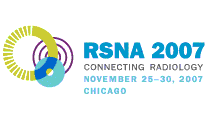
Abstract Archives of the RSNA, 2007
SSM26-06
Correlation between Clinical Toxicities and Dosimetric Parameters following Whole Pelvis (WP) versus Prostate Only (PO) Radiation for Prostate Cancer (CAP) Using Intensity Modulated Radiation Therapy (IMRT)
Scientific Papers
Presented on November 28, 2007
Presented as part of SSM26: Radiation Oncology and Radiobiology (Genitourinary Malignancies)
Curtiland Deville MD, Presenter: Nothing to Disclose
Stefan Both PhD, Abstract Co-Author: Nothing to Disclose
Neha Vapiwala MD, Abstract Co-Author: Nothing to Disclose
The benefit of pelvic lymph node irradiation in patients (pts) with intermediate- or high-risk CAP has been reported, yet use of WP fields remains controversial IMRT is accepted as a relatively safe method of dose escalation in CAP. While toxicities from WP radiation using 3-D conformal techniques are well documented, limited data exist regarding toxicities from IMRT-based WP treatment. This study was undertaken to analyze whether there is increased early morbidity associated with WP IMRT as compared to PO IMRT.
We analyzed 12 pts with intermediate- or high-risk CAP undergoing definitive IMRT with concurrent androgen ablation (AA) at our institution from 11/05 to 2/06. All patients underwent CT simulation and planning using Oncentra Treatment Planning System and predefined critical organ dose constraints (rectum: V45<40%, V65<20%; bladder: V45<25%, V65<50%; small bowel: V45<95%). Half of pts received initial WP IMRT to 45 Gy; half received PO IMRT. All pts received a total dose of 79.2 Gy to prostate. Gastrointestinal (GI), genitourinary (GU), and rectal toxicities were scored according to RTOG morbidity grading, both acutely and during a follow-up period of up to 14 months. Mean follow-up was 10 months. Dose-volume histograms (DVHs) were reviewed for rectum and bladder, and for small bowel in WP pts. A student t-test was used to detect statistically significant differences in the V40, V45, V50, V65, V70 doses for bladder and rectum between the PO and WP groups.
Five pts (83%) treated with WP IMRT experienced grade 1/2 GI toxicity in the acute setting, with anti-diarrheal medication used by 4 pts (66%). Only 1 pt (17%) reported persistent grade 1 toxicity during the follow-up period. PO pts reported no GI toxicity either acutely or in follow-up. All pts reported grade 1/2 GU toxicity acutely. In follow-up, grade 1/2 GU toxicity was recorded in 4 pts (66%) in the WP group, but only 1 PO pt (17%). All 5 of these pts had a history of benign prostatic hypertrophy and/or bladder outlet obstruction prior to IMRT. Rectal toxicities were similar between the 2 groups, both in the acute and follow-up periods. Three WP pts (50%) and 2 PO pts (33%) reported acute grade 1/2 rectal toxicity consisting of proctitis or rectal bleeding. In follow-up, only 1 pt (17%) in each group reported grade 1/2 rectal toxicity. No grade 3 or higher toxicity was reported at anytime. Based on analysis of bladder and rectum doses (V40, V45, V50, V65, V70), there was no statistically significant difference between the WP and PO groups (0.12<p<0.98).
In this group of CAP pts treated definitively with either WP or PO IMRT and concurrent AA, we found no statistically significant difference in bladder and rectal DVHs based on IMRT field size. These results correlate well with the clinical findings for rectal toxicity. Correlation with bladder morbidity is debatable due to preexisting conditions in this population. Extended follow-up and increased sample size may reveal statistical differences and improved correlation of clinical toxicities with dosimetry, ultimately facilitating a more informed consideration of the risks associated with WP lymph node irradiation in the IMRT era.
Deville, C,
Both, S,
Vapiwala, N,
Correlation between Clinical Toxicities and Dosimetric Parameters following Whole Pelvis (WP) versus Prostate Only (PO) Radiation for Prostate Cancer (CAP) Using Intensity Modulated Radiation Therapy (IMRT). Radiological Society of North America 2007 Scientific Assembly and Annual Meeting, November 25 - November 30, 2007 ,Chicago IL.
http://archive.rsna.org/2007/6001853.html

